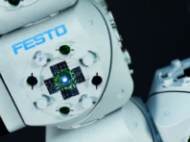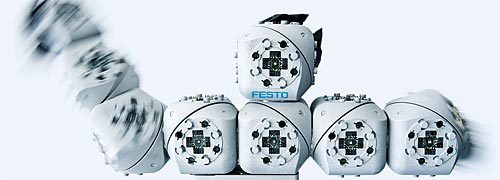Modular robots – Festo Molecubes
 Modularization is a basic principle of living nature: organisms consist of molecules and cells that use genetic programming in order to group together to form organs. Cell division and modularization are the two mutually opposed aspects of reproduction in living systems. Researchers around the world are trying to make a modular robot that can change its shape according to the needs at that time. In this article we’re going to write about such a concept from Festo, named Molecubes . In our future articles we’re going to write about several modular robots that have been developed.
Modularization is a basic principle of living nature: organisms consist of molecules and cells that use genetic programming in order to group together to form organs. Cell division and modularization are the two mutually opposed aspects of reproduction in living systems. Researchers around the world are trying to make a modular robot that can change its shape according to the needs at that time. In this article we’re going to write about such a concept from Festo, named Molecubes . In our future articles we’re going to write about several modular robots that have been developed.
Their project is a further development of the “Molecube Systems” of Cornell University, Ithaca, USA, in the third generation. The geometrical basis of this system is a cube and the Molecubes can connect themselves to others at every side. The two halves of a Molecube module rotate about the axis defined by two diagonally opposite corners. By linking together several Molecube elements, a practically unlimited number of spatial movement variants for the entire system can be realized. The end modules can also take the form of Molecubes with grippers, cameras or drive shafts.
The new configuration of an element needed to be formed is directly transferred to all the Molecubes within the system. That ensures that the energy supply and the transmission of signals between Molecubes stays preserved.
The Molecubes can be programmed in four different ways, ranging from manual to fully automated programming. High-level programming uses an interface for numerical calculations on the basis of matrices, similar to the MATLAB program, which allows programming with direct drive commands, sensor signals, and the application of internal variables and of data flow control commands. Direct programming is done via the ARM-processor interface where experienced users program the robot directly in the programming language C++. Machine learning enables fully automatic programming by means of mechanical learning processes at the highest level for research purposes is possible. Reinforcement learning and evolutionary algorithms are the key words in this context. Graphic emulation provides a realistic graphic and physical emulation allows the robot to be tested and operated virtually. In virtual reality, the user can control geometric and physical parameters and for instance monitor a robot’s collision behavior.
The developers said that the next development phase of Molecubes will be focused to drive forward mechanical and electronic integration. They also want to reduce the size of Molecubes, thus making them more versatile.
The ability to transform and adapt or even replace a modular part by using one of the functional modules that isn’t used at that moment makes transformable robots much more useable than robots with rigid structure. It is very probable that this idea will establish its application in a wide variety of new robots suitable for exploration and multitasking.










Leave your response!